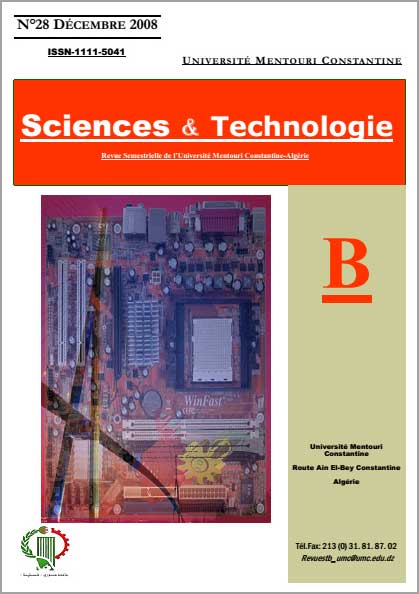MODELLING OF ENVIRONMENT EFFECT ON THE FATIGUE OF AN AISI 316L STEEL
Mots-clés :
Austenitic stainless steel, fatigue, corrosion, pits, airRésumé
The analysis of the behaviour of austenitic stainless steels, under dynamic stress in physiological medium, remains important in order to determine their lifetime when they are used in implantology. In this
purpose, simulations of fatigue corrosion of pre-notched specimens were carried out. Input notch data were taken from stable pits obtained by preliminary polarization tests in a solution of FeCl2, by taking two different concentrations (0,5 and 1M). Calculations were made using effective mechanical and electrochemical conditions observed on human body implants. Two fatigue models have been applied. Höeppner model is only a mechanical one, whereas Newman model adds chemical effect.
Numerical results indicates the number of cycles leading to critical size of pits-to-crack transition and then to failure. Furthermore, the effect of the initial notch size on fatigue behaviour of the stainless steel is highlighted. Both models indicate that decreasing initial notch size raises the number of cycles to failure.
Adding chemical action to mechanical one accelerates the damage, in general. However, at higher sizes, one can observe a slowing down of the chemical effect. The curve of Wöhler for different mediums and
values of applied stress shows that the mechanical action has much more influence when high loads are applied. As the stress applied decreases, the electrochemical effect becomes extensive and reduces considerably the lifetime of material. The prediction of lifetime needs thus to include the effect of other parameters, such as stress frequency, in order to compare it with real implant lifetime.
Références
R. SCHMIDT, Comportement des matériaux dans les milieux
biologiques, Presses Polytechniques et Universitaires
Romandes, 1999.
D.W. HOEPPNER, A. TAYLOR, V. CHANDRASEKARAN,
Review of Pitting Corrosion Fatigue Models, Structural
Integrity for the Next Millennium, Books in the International
Committee on Aeronautical Fatigue, (ICAF) series, ICAF20,
N. PEREZ, Fracture mechanics, Kluwer Academic Publishers,
J.C. NEWMAN, I.S. RAJU, An empirical stress intensity
factor equation for a surface crack, Engineering Fracture
Mechanics, Vol. 15, Issues 1-2, 1981, pp. 185-192.
Z. RUOXUE, M. SANKARAN, Reliability-based
reassessment of corrosion fatigue life, Structural safety, Vol.
, 2001, pp. 77-91.
H. SEDJAL, L. ROUIBAH, F. HELLAL, Modélisation de la
durée de vie d’un acier inoxydable austénitique de type 316L,
préalablement piqûré, soumis à une sollicitation dynamique
par flexion, Matériaux 2006 2ème conférence interdisciplinaire
sur les matériaux, Dijon, France 13-17 Nov 2006.
D. LANDOLT, Corrosion et chimie de surfaces des métaux,
Presses Polytechniques et Universitaires Romandes,
Lausanne, 1993.
U. KAMACHI MUDALI, T.M. SRIDHAR, R. BALDEV,
Corrosion of bio implants, Sadhana, Vol. 28, Parts 3 & 4,
June-August 2003, pp.601–637.
S. BRAHMI, Etude de la propagation des cracks de fatigue
dans les matériaux métalliques et des conséquences des
processus de déformation plastique à fond de cracks, Thèse de
Doctorat, Université Paris VI, 1991.
PO-FU KUO, Notch effect on high-cycle corrosion fatigue
for AISI 347 stainless steel, PhD Thesis, NCU, Taiwan, 2003.
G. MURTAZA, R. AKID, Empirical corrosion fatigue life
prediction models of high strength steel, Engineering Fracture
Mechanics, Vol. 67, 2000, pp. 461-474.
S. LAMPMAN, Fatigue and fracture properties of stainless
steel, Fatigue and fracture Handbook, Vol. 19, ASM
International, 1996.
H. P. LIEURADE, Essais de fatigue- corrosion, Techniques
de l’ingénieur, M135, 1996
Téléchargements
Publié-e
Comment citer
Numéro
Rubrique
Licence
Les auteurs publiant dans cette revue acceptent les termes suivants :- Les auteurs détiennent le droit d'auteurs et accordent à la revue
le droit de première publication, avec l’ouvrage disponible simultanément [SPÉCIFIER LA PÉRIODE DE TEMPS] après publication, sous la licence Licence d’attribution Creative Commons qui permet à d'autres de partager l'ouvrage en en reconnaissant la paternité et la publication initiale dans cette revue. - Les auteurs peuvent conclure des ententes contractuelles additionnelles et séparées pour la diffusion non exclusive de la version imprimée de l'ouvrage par la revue (par ex., le dépôt institutionnel ou la publication dans un livre), accompagné d'une mention reconnaissant sa publication initiale dans cette revue.
- Les auteurs ont le droit et sont encouragés à publier leur ouvrage en ligne (par ex., dans un dépôt institutionnel ou sur le site Web d'une institution) avant et pendant le processus de soumission, car cela peut mener à des échanges fructueux ainsi qu'à un nombre plus important, plus rapidement, de références à l’ouvrage publié (Consulter The Effect of Open Access).


